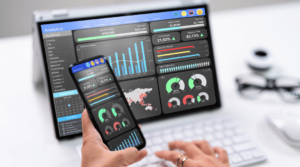Marketing Analytics: Turning Data into Insights
Welcome to the world of marketing analytics, where numbers come to life and transform into powerful insights that drive business growth. In today’s digital age, data is abundant, but its real value lies in how we interpret and utilize it to make informed decisions. In this comprehensive guide, we’ll delve into the realm of marketing analytics, exploring its significance, methodologies, and practical applications in turning raw data into actionable insights.
Understanding the Significance of Marketing Analytics
Marketing analytics is the process of measuring, managing, and analyzing marketing performance to maximize effectiveness and optimize return on investment (ROI). In essence, it’s about harnessing data to understand customer behavior, evaluate marketing strategies, and make data-driven decisions.
1. Informed Decision Making
At its core, marketing analytics empowers businesses to make informed decisions based on data rather than guesswork. By analyzing consumer behavior, market trends, and campaign performance, organizations can gain valuable insights that guide strategic planning and execution. Whether it’s deciding where to allocate marketing budgets, which channels to prioritize, or what messaging resonates best with the target audience, marketing analytics provides the necessary intelligence to make smart, data-driven decisions.
2. Optimizing Marketing ROI
In today’s competitive landscape, maximizing return on investment (ROI) is paramount for businesses of all sizes. Marketing analytics enables organizations to optimize their marketing efforts by identifying high-performing campaigns, channels, and audience segments. By allocating resources more efficiently and focusing on initiatives that yield the highest ROI, businesses can drive revenue growth while minimizing wastage and inefficiencies.
3. Understanding Customer Behavior
One of the key advantages of marketing analytics is its ability to deepen understanding of customer behavior. By analyzing data from various touchpoints such as website visits, social media interactions, and email engagement, businesses can uncover valuable insights into customer preferences, purchase patterns, and decision-making processes. This deeper understanding allows businesses to tailor their marketing strategies and offerings to better meet the needs and desires of their target audience, ultimately driving higher levels of engagement, loyalty, and satisfaction.
4. Staying Agile and Adaptive
In today’s fast-paced digital environment, agility and adaptability are essential for staying ahead of the curve. Marketing analytics provides businesses with real-time insights that enable them to quickly identify emerging trends, capitalize on opportunities, and respond effectively to changing market dynamics. Whether it’s adjusting campaign tactics on the fly, launching new products based on consumer demand, or pivoting strategies in response to competitive threats, marketing analytics empowers organizations to stay agile and adaptive in an ever-evolving marketplace.
5. Continuous Improvement
Finally, marketing analytics facilitates a culture of continuous improvement within organizations. By measuring and analyzing performance metrics on an ongoing basis, businesses can identify areas for optimization and refinement. Whether it’s tweaking ad creatives for better engagement, refining targeting parameters for higher conversion rates, or experimenting with new marketing channels and tactics, marketing analytics provides the insights needed to iterate and improve over time, driving sustained growth and success.
The Power of Data-Driven Decision Making
In today’s competitive landscape, businesses cannot afford to rely on guesswork or intuition alone. Data-driven decision making empowers organizations to base their strategies on concrete evidence rather than gut feelings. By leveraging marketing analytics, businesses can gain valuable insights into consumer preferences, market trends, and campaign performance, enabling them to make informed decisions that drive growth and profitability.

Methodologies of Marketing Analytics
Data Collection and Aggregation
The journey of marketing analytics begins with data collection. This involves gathering relevant information from various sources, including website traffic, social media interactions, email campaigns, and customer transactions. Modern analytics tools make this process seamless, allowing businesses to collect and aggregate data in real-time from multiple channels.
1. Multi-Channel Data Integration
In today’s digital age, consumer interactions occur across a multitude of channels—from websites and social media platforms to email and mobile apps. Effective marketing analytics requires integrating data from these diverse channels into a centralized platform or database. This integration ensures a holistic view of customer interactions and enables businesses to track the entire customer journey, from initial awareness to conversion and beyond.
2. Real-Time Data Capture
With the advent of advanced analytics tools and technologies, data collection is no longer a static, batch process. Instead, businesses can capture data in real-time as it’s generated, allowing for immediate insights and responsiveness. Real-time data capture enables businesses to monitor customer interactions as they happen, identify trends as they emerge, and take proactive measures to capitalize on opportunities or address challenges in a timely manner.
3. Data Quality Assurance
Quality is paramount when it comes to data collection. Poor-quality data can lead to erroneous insights and misguided decisions. To ensure accuracy and reliability, businesses must implement rigorous data quality assurance measures throughout the collection process. This includes validating data inputs, detecting and correcting errors, and maintaining data integrity over time. By investing in data quality assurance, businesses can trust the insights derived from their analytics efforts and make confident decisions based on accurate information.
4. Compliance and Privacy Considerations
In an era of heightened data privacy regulations and consumer expectations, businesses must prioritize compliance and privacy considerations when collecting and aggregating data. This involves adhering to relevant regulations such as GDPR (General Data Protection Regulation) and CCPA (California Consumer Privacy Act), obtaining proper consent for data collection and usage, and implementing robust security measures to protect sensitive information. By respecting consumer privacy rights and complying with regulatory requirements, businesses can build trust with their audience and mitigate the risk of legal and reputational repercussions.
5. Data Enrichment and Enhancement
In addition to collecting raw data, businesses can enhance their datasets through data enrichment and enhancement techniques. This involves augmenting existing data with additional information sourced from third-party providers or internal sources. For example, businesses can enrich customer profiles with demographic data, purchase history, or behavioral insights to gain a more comprehensive understanding of their audience. By enriching their datasets, businesses can unlock deeper insights and uncover hidden opportunities for personalization and targeting.
Data Analysis and Interpretation
Once the data is collected, it’s time to dive into data analysis. This step involves examining the information to identify patterns, trends, and correlations that can provide valuable insights into consumer behavior and market dynamics. Advanced analytics techniques such as predictive modeling, regression analysis, and machine learning algorithms are often employed to extract meaningful insights from large datasets.
Performance Measurement and Optimization
The final stage of marketing analytics is performance measurement and optimization. This involves evaluating the effectiveness of marketing campaigns and initiatives based on predefined KPIs (Key Performance Indicators) such as conversion rates, customer acquisition cost, and ROI. By analyzing the performance metrics, businesses can identify areas for improvement and optimize their marketing strategies for better results.
Practical Applications of Marketing Analytics
Customer Segmentation and Targeting
One of the key benefits of marketing analytics is its ability to segment customers based on their demographics, behaviors, and preferences. By dividing the target audience into distinct groups, businesses can tailor their marketing messages and offerings to better meet the needs of each segment, thereby increasing engagement and conversion rates.
1. Identifying Segmentation Criteria
Before diving into segmentation, businesses must first identify relevant criteria for dividing their audience into distinct segments. These criteria can include demographic factors such as age, gender, income, and location, as well as psychographic factors such as lifestyle, interests, values, and attitudes. Additionally, businesses may consider behavioral data such as purchase history, browsing behavior, and engagement with marketing campaigns. By understanding the characteristics and preferences of their audience, businesses can create meaningful segments that facilitate targeted marketing efforts.
2. Creating Meaningful Segments
Once segmentation criteria are established, businesses can create meaningful segments that enable them to tailor their marketing strategies and offerings to meet the unique needs and preferences of each group. Segments may be based on factors such as age cohorts (e.g., millennials, Gen Z), life stages (e.g., students, retirees), product preferences (e.g., high-end, budget-conscious), or purchase behavior (e.g., frequent buyers, first-time purchasers). By segmenting their audience effectively, businesses can deliver more relevant and personalized experiences that resonate with each segment.
3. Targeting Specific Segments
With segments identified, businesses can then target specific segments with tailored marketing messages and offerings. This involves crafting messaging, content, and promotions that speak directly to the needs, interests, and preferences of each segment. For example, a luxury fashion brand may target affluent customers with exclusive product launches and VIP events, while a budget airline may target price-conscious travelers with discounted fares and budget-friendly packages. By targeting specific segments, businesses can maximize the effectiveness of their marketing efforts and achieve higher levels of engagement and conversion.
4. Personalization and Customization
In today’s age of personalization, customers expect tailored experiences that cater to their individual needs and preferences. Customer segmentation and targeting enable businesses to deliver personalized marketing messages and offerings that resonate with each segment. This may include personalized product recommendations, targeted email campaigns, customized website content, or dynamic ad creatives. By leveraging data insights to personalize the customer experience, businesses can enhance engagement, loyalty, and satisfaction, ultimately driving greater results and ROI.
5. Iterative Optimization
Customer segmentation and targeting are not static processes; they require continuous refinement and optimization over time. As market dynamics change and consumer preferences evolve, businesses must continually reassess their segmentation strategies and adjust their targeting tactics accordingly. This involves analyzing performance metrics, gathering feedback from customers, and experimenting with different segmentation criteria and targeting approaches. By adopting an iterative approach to segmentation and targeting, businesses can stay agile and adaptive, maximizing the effectiveness of their marketing efforts in an ever-changing landscape.
Personalized Marketing Campaigns
In the age of personalization, generic marketing campaigns no longer cut it. Marketing analytics enables businesses to create personalized experiences for their customers by leveraging data insights to deliver targeted messages and offers. Whether it’s personalized email recommendations, dynamic website content, or customized ad campaigns, personalization can significantly enhance the effectiveness of marketing efforts.
Predictive Analytics and Forecasting
Predictive analytics is a powerful tool that uses historical data to forecast future trends and outcomes. By analyzing past performance and identifying patterns, businesses can make informed predictions about future market dynamics, customer behavior, and sales trends. This allows them to anticipate market shifts, identify potential opportunities, and proactively adjust their strategies to stay ahead of the curve.
Conclusion
In conclusion, marketing analytics is not just about crunching numbers; it’s about unlocking the hidden potential within data to drive business growth and innovation. By harnessing the power of data-driven insights, businesses can gain a competitive edge in today’s fast-paced market environment. From understanding customer behavior to optimizing marketing campaigns, the possibilities with marketing analytics are endless. So, if you’re ready to take your marketing efforts to the next level, embrace the power of analytics and turn data into insights that propel your business forward.






